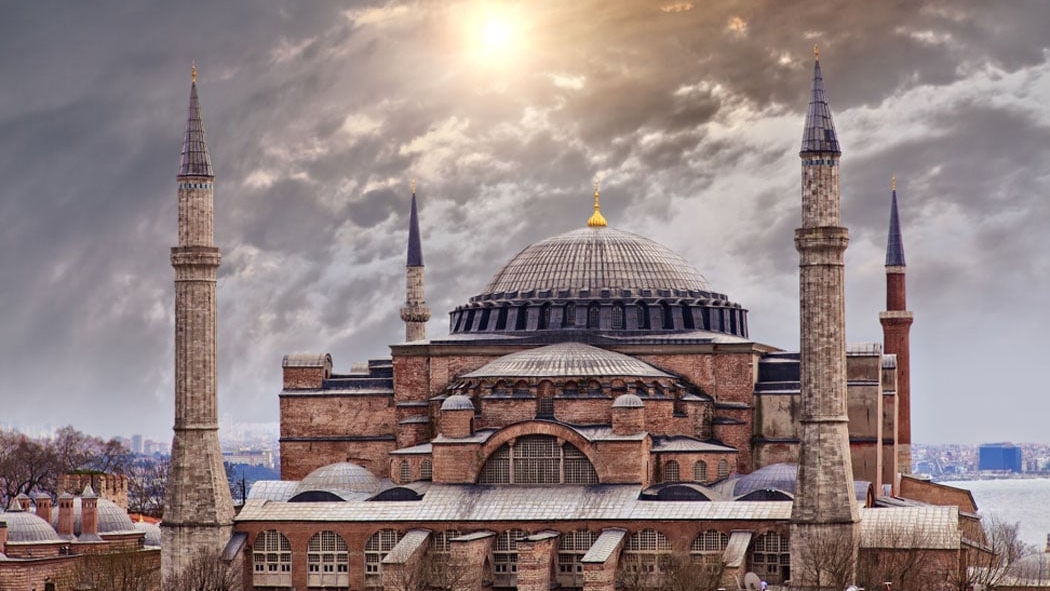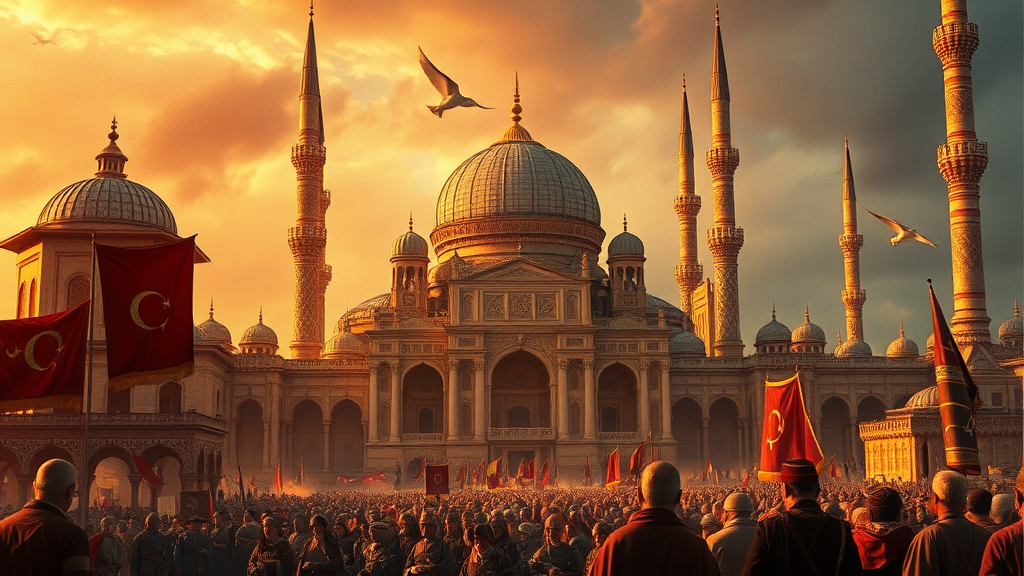Last Updated on juli 28, 2025 by Ideal Editor
🕌 Ottoman Empire’s Rise and Fall: The Empire That Shaped Continents
The Ottoman Empire stood as one of history’s most powerful and enduring empires, lasting from 1299 to 1922. At its zenith, it stretched from the gates of Vienna in the west to the Persian Gulf in the east, and from Crimea in the north to Yemen and Sudan in the south. The Ottomans were more than conquerors. They were administrators, architects, patrons of the arts, and preservers of classical knowledge. For over six centuries, the empire left its mark on three continents, influencing trade, diplomacy, religion, and culture. This blog post takes you through the Ottoman Empire’s Rise and Fall, its golden age, its struggles with modernity, and its eventual collapse—tracing the Ottoman journey from imperial glory to the birth of modern Turkiye.
👑 The Rise to Power (1453–1566)
🏰 Conquest of Constantinople (1453)
The conquest of Constantinople was a defining moment not only for the Ottomans but for world history.
🔹 Led by: Sultan Mehmed II (known as Fatih, “The Conqueror”)
🔹 Date: May 29, 1453
🔹 Outcome:
- Brought an end to the Byzantine Empire
- Transformed Constantinople into Istanbul, the new imperial capital
- Enabled control over vital Silk Road and Mediterranean trade routes
📊 Infographic: Constantinople Conquest Snapshot
| Date | Ruler | Outcome |
|---|---|---|
| May 29, 1453 | Mehmed II 🏹 | Byzantine Empire ends; Istanbul established |
Mehmed II turned Istanbul into a thriving cosmopolitan capital, inviting Greek, Armenian, and Jewish communities to repopulate the city, establishing the Ottoman model of religious pluralism.

📈 The Classical Golden Age (1453–1566)
Under rulers like Bayezid II, Selim I, and most famously Suleiman the Magnificent, the Ottomans entered their Golden Age.
🧑⚖️ Suleiman the Magnificent (r. 1520–1566):
- Extended the empire into Hungary, North Africa, and Mesopotamia
- Balanced Sharia law with Kanun, a civil law code
- Presided over a cultural renaissance—architecture, poetry, science, and the arts thrived
🏛️ Architectural Glory: Mimar Sinan, chief architect, built iconic structures like the Süleymaniye Mosque and hundreds of bridges, schools, and hospitals.
📊 Table: Ottoman Golden Age Achievements
| Sector | Highlights |
|---|---|
| Military | Naval control in Eastern Mediterranean; elite Janissary corps |
| Culture | Court poets, miniatures, and calligraphy flourished |
| Architecture | Grand mosques and public buildings under Mimar Sinan |
| Governance | Codification of laws; efficient provincial rule |

⚖️ The Administration and Society
🏛️ Core Institutions of Power
The Ottoman state blended Islamic law, Turco-Mongol traditions, and Byzantine bureaucratic practices into a unique imperial system.
Key Institutions:
- Sultan: Supreme political and religious leader
- Grand Vizier: Head of government and imperial cabinet
- Divan: Council of viziers and officials
- Millet System: Allowed religious minorities to manage their own schools, courts, and places of worship
Military Framework:
- Janissaries: Elite infantry unit of conscripted Christian boys (Devshirme system)
- Sipahis: Provincial cavalry who received land grants in return for military service (timars)
This decentralized but loyal administrative structure allowed the Ottomans to govern a multi-ethnic, multi-religious population for centuries.
🧨 Crisis, Stagnation, and Reforms (1566–1792)
📉 Seeds of Decline
After Suleiman, a gradual decline began, driven by:
- Succession problems and harem politics
- Corruption among provincial governors
- Janissary revolts and loss of discipline
- Technological lag behind rising European powers
📉 Chart: Decline Indicators Over Time
| Period | Indicator | Status |
|---|---|---|
| 1600s | Military innovation | Lagging ⚠️ |
| 1650–1750 | Economic competitiveness | Weak |
| 1700s | Internal revolts | Frequent 🔥 |
| 18th century | European land losses | Accelerating 📉 |
⚔️ Military Defeats and European Pressure
- 1571 – Battle of Lepanto: Naval defeat by a European Holy League
- 1699 – Treaty of Karlowitz: Hungary ceded to Austria
- 1774 – Treaty of Küçük Kaynarca: Crimea lost to Russia
These defeats signaled the empire’s waning dominance and the growing threat of European imperialism.
🔁 Reform Attempts and Internal Struggles (1792–1908)
🔧 The Tanzimat Reforms (1839–1876)
In response to growing weakness, the Ottoman government launched the Tanzimat, or “Reorganization” reforms.
📋 Key Goals:
- Modernize army and administration
- Centralize state control
- Enforce legal equality for Muslims, Christians, and Jews
- Introduce modern schools, newspapers, and postal systems
Despite good intentions, Tanzimat faced opposition from conservative elites and proved uneven in implementation.
⚠️ Abdulhamid II and Autocracy (1876–1909)
- Introduced a constitution in 1876—then suspended it
- Ruled as an autocrat, using censorship and surveillance
- Invested heavily in infrastructure: railways, telegraphs, and schools
📊 Pros & Cons of Tanzimat and Abdulhamid Era
| Aspect | Benefit | Drawback |
|---|---|---|
| Legal | Equality for all subjects | Angered Muslim elites |
| Military | Western-style modernization | Expensive and uneven |
| Press | Education and literacy grew | Freedom of expression curtailed 🛑 |

🏁 Collapse of the Empire (1908–1922)
🧨 Young Turk Revolution (1908)
- Restored the 1876 Constitution
- Empowered the Committee of Union and Progress (CUP)
- Pushed for Turkification, sparking ethnic unrest among Arabs, Armenians, Greeks, and Kurds
🌍 World War I and the Empire’s End
- Joined Central Powers (Germany and Austria-Hungary)
- Lost major battles and territories
Key Events:
- Gallipoli Campaign (1915): Ottoman victory, symbol of national pride
- Armenian Deportations: A humanitarian crisis with lasting international controversy
- Arab Revolt (1916): British-backed uprising in the Arabian Peninsula
📉 Treaty of Sèvres (1920)
- Ottoman Empire dismantled
- Foreign control over Anatolia, Levant, and Mesopotamia
The Rise of Turkish Nationalism
In response to occupation and disintegration, Mustafa Kemal (Atatürk) led a national resistance movement.
📜 Milestones:
- 1919–1922: Turkish War of Independence
- 1922: Abolition of the Sultanate
- 1923: Founding of the Republic of Turkey
Sultan Mehmed VI, the last Ottoman ruler, went into exile—ending a 623-year-old dynasty.
🌐 Legacy of the Ottoman Empire
🧭 Cultural Contributions:
- Architecture: Blue Mosque, Süleymaniye, Topkapı Palace
- Cuisine: Fusion of Central Asian, Persian, Arab, and Balkan flavors
- Literature & Music: Rich poetic and musical traditions still celebrated today
⚖️ Administrative Innovations:
- Millet System: Early model for religious pluralism
- Timar System: Precursor to modern land-tax structures
🌍 Geopolitical Impact:
- Drew the modern borders of the Middle East and Balkans
- Inspired both pan-Islamic and secular-nationalist movements
- Continues to influence Turkish identity and politics
❓FAQs: Ottoman Empire’s Rise and Fall Explained
- Why did the Ottoman Empire fall?
A combination of internal corruption, military defeats, ethnic tensions, and failure to keep pace with European modernization. - Who was the greatest Ottoman sultan?
Suleiman the Magnificent—military expansion, legal reform, and cultural patronage. - What was the Millet system?
A system allowing religious minorities autonomy in legal and educational matters under their own leaders. - How did World War I affect the Ottoman Empire?
It accelerated the empire’s collapse through military defeat, foreign occupation, and nationalist uprisings. - What was the Tanzimat reform?
A 19th-century modernization effort to centralize and secularize the state, promote equality, and strengthen institutions.




